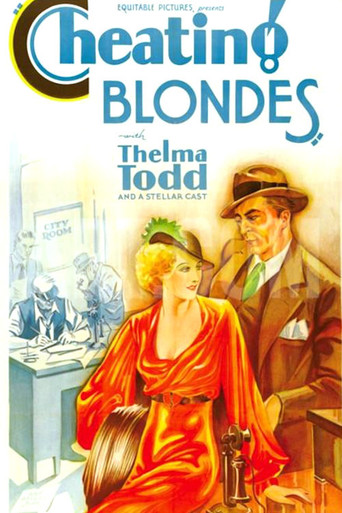

Too much of everything
... View MoreThe greatest movie ever!
... View MoreDisappointment for a huge fan!
... View MoreExactly the movie you think it is, but not the movie you want it to be.
... View MoreThelma Todd had that very rare presence for 1930's blonde bombshells that made her seem very modern, an actress ahead of her times, yet someone you wouldn't mind paling around with. Comedy teams such as Wheeler and Woolsey, the Marxx Brothers and Laurel and Hardy had the privilege of her as a worthy foil, and her series of shorts with Zasu Pitts and Patsy Kelly made her a comedy legend. Her shocking death in 1935 left a major void, but unlike fellow blonde "moderns" who met early deaths (Jean Harlow and Carole Lombard), her legend is limited to those who have discovered her work and come to appreciate her rather than the superstars Harlow and Lombard continue to remain."Cheating Blondes" is a poverty row drama, filled with some delicious pre-code elements, that appears to be greatly edited because of some obvious continuity flaws. It seems that a reel or two are no longer in circulation, and this adds a lot of questions which the surviving print does not answer. The plot, from what I gathered, concerns two sisters (both played by Todd) who are estranged. One of them is a stage star who abandons her career, and when the other one is involved in a murder investigation, she passes herself off as her sister, taking over her role in a musical revue. Of course, pesky reporters recognize her and begin to investigate the fact that indeed, she is the one on the lamb.Of course, there are extenuating circumstances. The man who is killed basically while drunk tried to rape Todd (with his wife in the next room!), and even though neighbors heard the attack and her screams for him to stop, not one of them steps up to her defense. After all, beauty is a curse, and they believe she must have done something to prompt such an attack. The other sister is really an inconsequential character, and there is never really any development as to why the sisters are estranged and how the one on the run got into take over for her in the first place. This is deemed as the fault of the missing reels which seem to be important to explaining everything that the other reels do not.The surviving print does show a woman, assumed to be the unimportant character of the sister, in a glamorous setting towards the beginning, while the other sister seems to be living in squalor. Then comes the shooting sequence, and all of a sudden, her character is fluttering around in a butterfly costume while a reporter who knew her previously watches her suspiciously. It's not difficult to figure out what really happened, and for a poverty row film, it seems pretty elaborate if a bit creaky. But when Todd is on screen, all is bright in our world even if the character's is hidden behind scandal.
... View MoreAlmost any movie with Thelma Todd is a must-see movie, and this one provides double value for all Thelma's fans as it supplies two Todds for the price of one. Needless to say, she is not only dressed to the nines, but cleverly delineates the two characters (twin sisters) that she so convincingly plays. However, it's not just Toddie that's the main attraction here. This film gives Ralf Harolde (who played nasties in many movies) by far the best role in his one hundred pictures' career. In fact, after this forceful role, you'd think he'd be set for life! He wasn't! As for Joseph Levering, the director here who paced the movie so cleverly, it seems he graduated from shorts to features, but disappeared from the directorial ranks after making this movie, coming back in 1938 and 1939 with eight "B" westerns! Also in the support cast of "Cheating Blondes", you'll notice Milton Wallis in his only movie appearance or credit. He plays the producer, Mike Goldfish, with considerable relish, and my guess is that he was an executive or lawyer associated with Larry Darmour's Majestic Pictures and/or Equitable Motion Pictures Corporation. Darmour made a fortune with the Mickey McGuire series, starting in 1927 and ending with "Mickey's Medicine Man" in 1934, so it's no wonder that by "B" standards, "Cheating Blondes" is so very lavishly produced. Available on an excellent Alpha DVD.
... View More